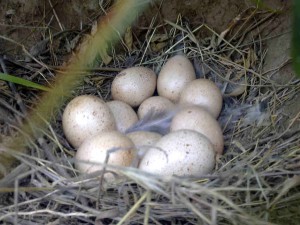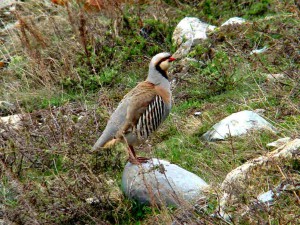
Alectoris chukar (Chukar)
The Chukar (Alectoris chukar) is a resilient and hardy bird species found in the rugged terrain of the Great Himalayan National Park (GHNP) in Himachal Pradesh. Known for its distinctive call and bold plumage, the Chukar is a member of the pheasant family and holds cultural as well as ecological significance in the Himalayan region. It is also the national bird of Pakistan.
Physical Appearance and Behavior
The Chukar is a medium-sized, plump bird with a greyish-brown back, buff underparts, and striking black and white bars on its flanks. One of its most distinguishing features is the black band running across its forehead, eyes, and down to the neck, forming a necklace-like pattern. It has red legs and a red beak.
Chukars are ground-dwelling birds, often seen in small coveys, especially during the non-breeding season. Their call, a repeated “chuk-chuk-chukar,” is where their name comes from and is commonly heard echoing across rocky hillsides in GHNP.
Habitat in GHNP
In the Great Himalayan National Park, Chukars prefer dry, open hillsides, grassy slopes, rocky outcrops, and scrub-covered ridges. They are typically found at elevations ranging from 1,200 to 3,500 meters, particularly in the Sainj and Tirthan valleys, which offer ideal terrain and cover for nesting and foraging.
Their nests are shallow scrapes on the ground, well-hidden under bushes or rocks. During the breeding season (spring to early summer), males become highly vocal and territorial.
Diet and Role in Ecosystem
Chukars are omnivorous, feeding on a wide variety of seeds, grains, berries, and insects. Their foraging behavior plays an essential role in seed dispersion and maintaining the ecological balance in the park’s mid-altitude ecosystems. In the harsher seasons, they exhibit an ability to thrive on minimal resources.
| Common name | Chukar |
| Scientific name | Alectoris chukar |
| Family | Phasianidae |
| Description | It is a resident bird of Himalayas and having black gorget encircling throat, barring on flanks. The bill and leg of this bird is red in colour. It prefers open rocky or grassy hills and also dry terraced cultivation. It is commonly found in an altitude of 2100-3960m |
Conservation and Threats
Globally, the Chukar is listed as a species of Least Concern by the IUCN due to its wide range and stable population. However, localized threats such as habitat disturbance, grazing, and illegal hunting exist outside protected zones. The Great Himalayan National Park, being a UNESCO World Heritage Site, offers safe and undisturbed habitat critical for its long-term survival in the region.
Cultural Significance
The Chukar is steeped in regional folklore and poetry, often symbolizing unrequited love, as the bird is believed to gaze longingly at the moon. Its presence in the Himalayas has made it a familiar subject in stories, songs, and even local proverbs.




